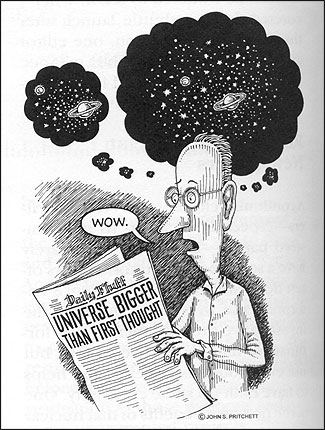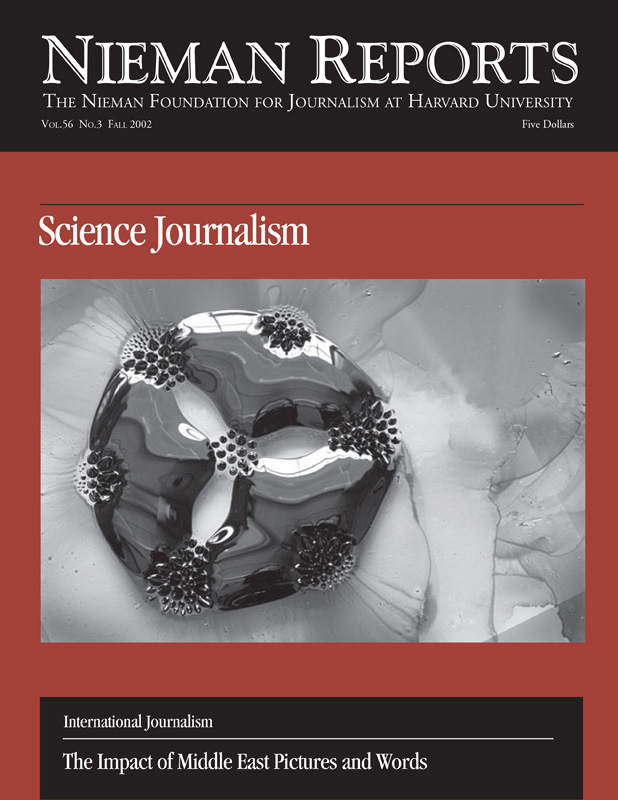
Cartoon by © John S. Pritchett.
Back in the early summer of 1999, just two years after I and a handful of reporters at the (Minneapolis) Star Tribune persuaded the senior editors to publish a weekly science page, the copyeditor I worked with leaned over the low partition separating our desks and said, “The vultures are in the trees.” The two of us, with significant help from other reporters, were having enormous fun each week putting together a page that was focused on hard science and medical research but that didn’t take itself too seriously. But we knew, given the nature of newspapers, that editors who knew virtually nothing about science or science journalism would eventually start imposing their views.
In the early days of designing the page, the copyeditor and I argued whether it would last as a home for pure science for one year or two. The page survived for nearly four years, although I recommended killing my own mutated creation in its third year.
The page ran with full color inside the “A” section of the newspaper on Wednesdays. That is highly valued real estate in a newspaper, and in the beginning it was justified by editors who saw the science page as a perfect “segment one enhancement”—a way to appeal to the better-educated readers. The paper had added all sorts of fluffy entertainment and shopping features (segment two enhancements) to the weekend paper, and our science page was seen as a good counterweight.
We did solid, in-depth science stories about physics, earth sciences, genetics, astronomy, cosmology, paleontology and climate. Especially climate. This was Minnesota, after all, where people actually debate whether elementary school children should stand at bus stops when the temperature drops to 20 degrees below zero Fahrenheit. But we also sent scientists and mathematicians to review the latest bad science movies, hired the magician The Amazing Randi to write about pseudoscience, and convinced a highly regarded humorist to write about why he didn’t like scientists.
The page was a hit. The extensive Twin Cities scientific community that includes the University of Minnesota, a host of smaller colleges, 3M, Medtronic and other high tech firms, loved the visibility the page gave to science. The more general audience of readers who are interested in science—some 25 to 35 percent of subscribers, according to the newspaper’s surveys—responded enthusiastically. Even editors who typically glazed over when I had proposed stories on neutrinos or interfacial engineering had nice things to say.
One of the hard rules I set for the page was that consumer-oriented “health news” was not allowed. The newspaper’s Variety section carried consumer health news regularly, so there was no need to dilute the science page with stories on the latest wonder drug or advice about how to cope with bunions. As an aging baby boomer I find myself increasingly drawn to stories of disease and physical decay, but they don’t belong on a science page. I was adamant in this view, to the point where I wouldn’t allow some health stories that involved good science. I feared the camel’s nose under the tent.
Pure medical research—a new procedure being developed to replace heart valves, or new understanding of how viruses invade cells—was allowed on the page. This distinction between science and health news was arbitrary, based on my instinct as a long-time science writer.
My reasons for keeping consumer health news off the page were straightforward. Science is increasingly important in our society, yet poorly understood and feared by most people. Newspapers, according to the surveys I have seen, are the primary source of scientific information for the vast majority of readers. Yet newspapers, with a few well-known exceptions, typically do a bad job covering science. Editors often are as poorly educated in science and as afraid of the subject as society in general. There is also a type of anti-intellectualism at play in many newsrooms, especially among mid-level editors. If a story is complicated, the thinking goes, the readers won’t understand it, so better not to run it.
Local television news organizations are even worse. Science stories are often given to the weather reporter, apparently on the theory that because weather is complicated, the reporter will understand particle physics. Most weather reporters I know don’t have even a cursory understanding of the science underlying global warming.
As time went on, some in the Star Tribune newsroom complained that our science page stories weren’t written with the average “reader customer” in mind. Others worried that we didn’t have stories on the page simple enough to attract readers who weren’t interested in science. The art department complained when we insisted on smaller graphics so there would be room for words. Even the humor on the page was criticized as being too subtle. After two years, the complaints began taking the form of orders on design and story mix.
The newspaper’s several health writers were told to write for the page on a strictly scheduled basis, whether they had decent science stories or not. Those writers, of course, did what they were good at—they wrote health stories. As the only science writer at the paper, I was pressured to produce more stories for the front page, ostensibly because science was so important that it needed to be out front. The science page quickly lost its focus and became a mishmash of light science fare and health stories all designed not to be too challenging. The page actually managed to make science boring.
I left the newspaper in 2000 to take a job as a senior news editor at Physics Today magazine. The science page had been an aimless mix of health and science for several months before I left. To be sure, there were occasional good stories on the page, but only occasional. The health reporters viewed the pages as an assigned burden, I was meeting my mandate to write for other parts of the newspaper, and the environmental and biotechnology writers were working on large-scale projects that didn’t fit the page. Several months after I was gone, so was the page. Killed, no doubt, after an editor asked why a health page was running in the middle of the “A” section when there was perfectly good health coverage back in Variety.
What happened at the Star Tribune was too bad for those of us who believe writing about science is a high journalistic calling. Unfortunately, it was predictable. Newspapers have historically tolerated science writing, not encouraged it. Health writing is fine, because everybody gets sick. But cosmology or paleontology? Only if you can relate the stories to the reader’s lifestyles.
The irony here is that the number of good science writers has grown dramatically thanks to programs such as the Knight Fellowship at MIT and the science writing program at the University of California, Santa Cruz. And it is clear that science stories are increasingly becoming part of the daily news cycle, with stories about genetics, biotechnology, nanotechnology and climate change becoming commonplace. One would think that newspaper editors would see the growing role of science in society and be insisting on high-visibility science beats.
Yet even The Boston Globe and The Dallas Morning News, newspapers that had two of the best science sections in the country, combined them with their health sections in recent years. At least those papers still have good science writers. The Star Tribune, over the protests of local scientists and readers, didn’t hire a new science writer after I left. Now, for the first time since Victor Cohn began covering science for the Tribune back in the 1950’s, there is no one on the beat. The science writer at the newspaper now is The New York Times or The Associated Press wire.
What has really been lost, of course, is coverage of local science. There are a lot of first-rate scientists in Minnesota, doing everything from looking for proton decay and neutrinos in detectors located deep in the Soudan Mine, to computerizing Jane Goodall’s early field notes to better understand the behavior of chimps. The local science stories are everywhere, and the Star Tribune isn’t covering them. Neither is the rival Pioneer Press across the river in St. Paul. That newspaper has won a couple of Pulitzer Prizes in recent years, but has never had a science writer.
There are still four health writers at the Star Tribune, however. A year after I left the paper, I asked the new health and science team leader—a decent editor transferred in from the public safety team—how science coverage was going. “Great,” he said. “We did a terrific job covering the nurses’ strike.” No doubt they did.
Jim Dawson is senior news editor at Physics Today. He was a reporter at the Star Tribune for 21 years and the science writer from 1988 until 2000. Dawson was a fellow in MIT’s Knight Science Journalism Fellowship in 1987-88.



